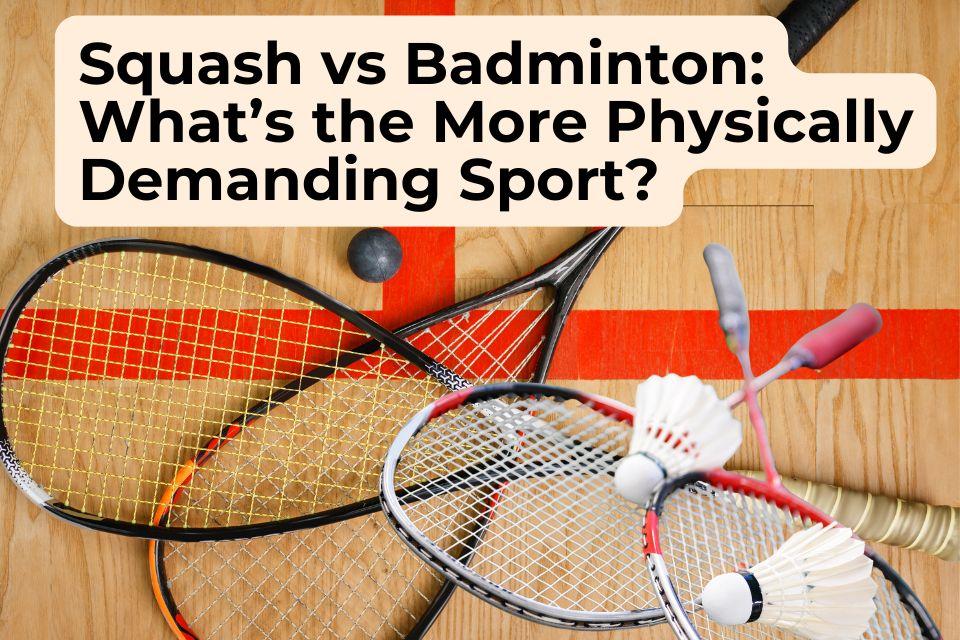


When it comes to racket sports, squash and badminton often top the list of the most intense and physically challenging games. Both demand agility, speed, reflexes, and stamina—but which one is truly the most physically demanding sport?
In this blog, we’ll compare squash and badminton across various aspects like court size, speed, endurance, and injury risks, to help you understand which sport pushes the body harder.
Badminton is recognized by the Guinness World Records as the world’s fastest racket sport, with shuttle speeds crossing 400 km/h at the professional level.
Explosive bursts: Players make short, sharp movements—lunges, jumps, and smashes.
Reaction speed: With shuttles traveling faster than a Formula 1 car, reflexes are critical.
Agility: Constant changes of direction test flexibility and coordination.
Stamina: Long rallies demand endurance, especially in singles.
Fun Fact: A professional badminton player can cover 6–7 km of movement in a single match through quick sprints and footwork.
Squash is played on a much smaller court but with continuous rallies and no breaks. Unlike badminton, the ball doesn’t stop moving unless it hits the floor twice.
Endurance & stamina: Squash rallies can last longer, requiring sustained energy.
Strength: The heavier racket and harder ball demand more arm and core power.
Anaerobic fitness: Squash is like interval training—fast-paced rallies mixed with recovery steps.
Mental toughness: Predicting wall rebounds and shot placement adds a tactical strain.
Fun Fact: Studies show that squash players can burn 800–1000 calories per hour, higher than most other sports.
Feature | Badminton | Squash |
Court Size | Larger (13.4m x 6.1m for doubles) | Smaller (9.75m x 6.4m enclosed court) |
Rally Speed | Shuttle > 400 km/h | Ball ≈ 200 km/h |
Movements | Jumps, lunges, explosive sprints | Quick sprints, continuous running |
Calories Burned/hr | 500–700 (competitive play) | 800–1000 |
Muscles Used | Legs, shoulders, wrists, core | Legs, arms, back, core |
Mental Pressure | Reflex-based, strategy heavy | Endurance-based, tactical positioning |
Badminton is more about explosiveness, reflexes, and high-intensity bursts. It demands lightning-fast reactions, agility, and flexibility.
Squash, on the other hand, requires greater stamina, muscular endurance, and sustained physical effort due to continuous rallies and a harder ball.
If we look strictly at calorie burn and endurance, squash edges ahead as the more physically demanding sport.
But in terms of speed, reflexes, and explosive power, badminton takes the crown.
The truth? Both are among the toughest racket sports, and the choice depends on whether you prefer endurance (squash) or explosiveness (badminton).
Conclusion
Squash and badminton may look similar at first glance, but their physical demands are unique. Badminton is the game of speed and agility, while squash is the test of strength and stamina.
Whichever sport you choose, both guarantee a killer workout, improved fitness, and endless fun. And if badminton is your pick, make sure you’re equipped with the best rackets, shoes, and shuttlecocks—available online at SportsGear24x7.
Frequently Asked Questions (FAQs)
Q1. Which sport burns more calories: squash or badminton?
Squash burns slightly more—around 800–1000 calories per hour, while badminton burns 500–700 calories per hour in competitive play.
Q2. Is squash harder than badminton?
Squash is more demanding on endurance and stamina, while badminton is tougher on speed, reflexes, and explosiveness. Both are physically challenging in different ways.
Q3. Which sport is better for beginners—squash or badminton?
Badminton is usually easier to pick up as a beginner, while squash requires more strength and stamina due to its relentless rallies.
Q4. Which sport is faster: squash or badminton?
Badminton is faster in terms of shuttle speed (over 400 km/h), while squash rallies last longer with continuous ball rebounds.
Q5. Can playing either sport improve fitness?
Yes! Both squash and badminton improve cardiovascular health, agility, strength, and coordination, making them excellent full-body workouts.